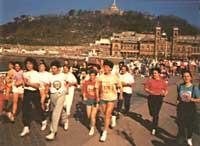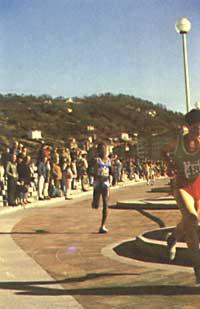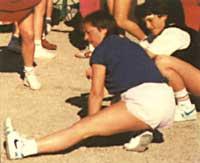Popular races and cardiac accidents
1990/09/01 Agirre, Jabier - Medikua eta OEEko kidea Iturria: Elhuyar aldizkaria

A popular or popular race has recently been held in Barcelona, bringing together more than sixty thousand people. This figure has broken all the brands in this type of sports tests. It must be said, however, that not all of these people participated and that most (or at least one important part) of those who came out were not trained athletes.
Attracting such people has great merit and seems just to give the warmest congratulations to those who have been organizing around this race. On the other hand, it is quite possible that more than one of the enrollees is now more motivated to follow a training program, as for others would be the occasion to review what had been used so far.
In previous races there was no complication, but a few weeks ago a 19-year-old died, after 10 kilometers, in an attempt to overcome a rather demanding slope before reaching the finish. It seems that this young man had passed by and had passed some medical recognition (but we have no record of it).
It is, therefore, a premature death, although not very common, associated with a physical exercise performed without adequate preparation. Sporadic workouts, occasional sessions, or weekend exercises are unprepared to deal with competitions and efforts. A distance of 11 km can be admitted for a trained athlete, but not for those who are not properly prepared. As Mario Prat, champion of marathon in Spain, points out at the same time as winner of the event, “this distance, the marathon race, is the same for athletes trained for the general public”, so the name of this type of race as “popular marathon” seems very adequate.

While the level of effort is similar, it is true that physical preparation for a sports specialty is valid for any other. If not, it is possible that an athlete, going from one sport to another with potentially contrary conditions, has complications derived from an undiagnosed heart disease.
The incidence of sudden death caused by exercise (this is called during exercise or 24 hours later) is very low. Statistically the lethal accident during exercise can be casual since there is a risk of cardiovascular death due to hidden coronary artery disease. The possibility of risk increases in predisposed persons, where dehydration, the increase of fatty acids, and the increase of the plasma levels of catecholamines facilitate the formation of thrombi within the coronary arteries, also increasing the electrical instability of the heart.
The risk of death in Bapate, during exercise, is especially high among people not used to exercise, which is a reason for predisposition, as demonstrated by a recent study in Seattle (USA). On the other hand, another study has shown that the risk of developing malignant arrhythmias is lower when the effects of physical exercise on the cardiovascular system have been shown (and one way to achieve this is training). Therefore, in cases of sudden death there would be a basic cause (originated by an anomaly of the heart, both structural and electrophysiological) and auxiliary factors, among which would include the absence of physical activity and excessive effort.
The medical review of athletes is a very discussed topic and the problem is not yet solved. Being a problem of great relevance, in the prevention of cardiovascular accidents that would occur during the exercise, there is no agreement when deciding how to perform the sports fitness exam, who should issue the certificate or what is the degree of reliability of these exams.

The cardiovascular study will be, however, expelling and before certain signs or symptoms (syncopes or presincopies, chest pain, unexpected fatigue, palpitations, unconventional puffs, absence of previous regular exercise, etc.) The exploration will be completed with the most appropriate complementary techniques. Stress test with ECG monitoring, echocardiogram, ECG monitoring using the Holter method, isotopes, etc. are some of these techniques.
The possibility of an episode of sudden death after a specific study is very small. However, there are strange reasons that escape medical observation. It cannot be fully stated that there is no risk to exercise. Linked to the first popular races or popular marathons, it is best to promote and promote the training programs themselves, whether under medical supervision or performed by athletes. Athletes should be aware of the importance and dangerousness of the problem.
The goal of such campaigns and messages would be double:
- Above all, encourage training among those who feel involved in a recreational activity.
- Promote sports action as a whole, affecting its positive aspects above all the possible risks to which sports activities can be exposed.

Gai honi buruzko eduki gehiago
Elhuyarrek garatutako teknologia




